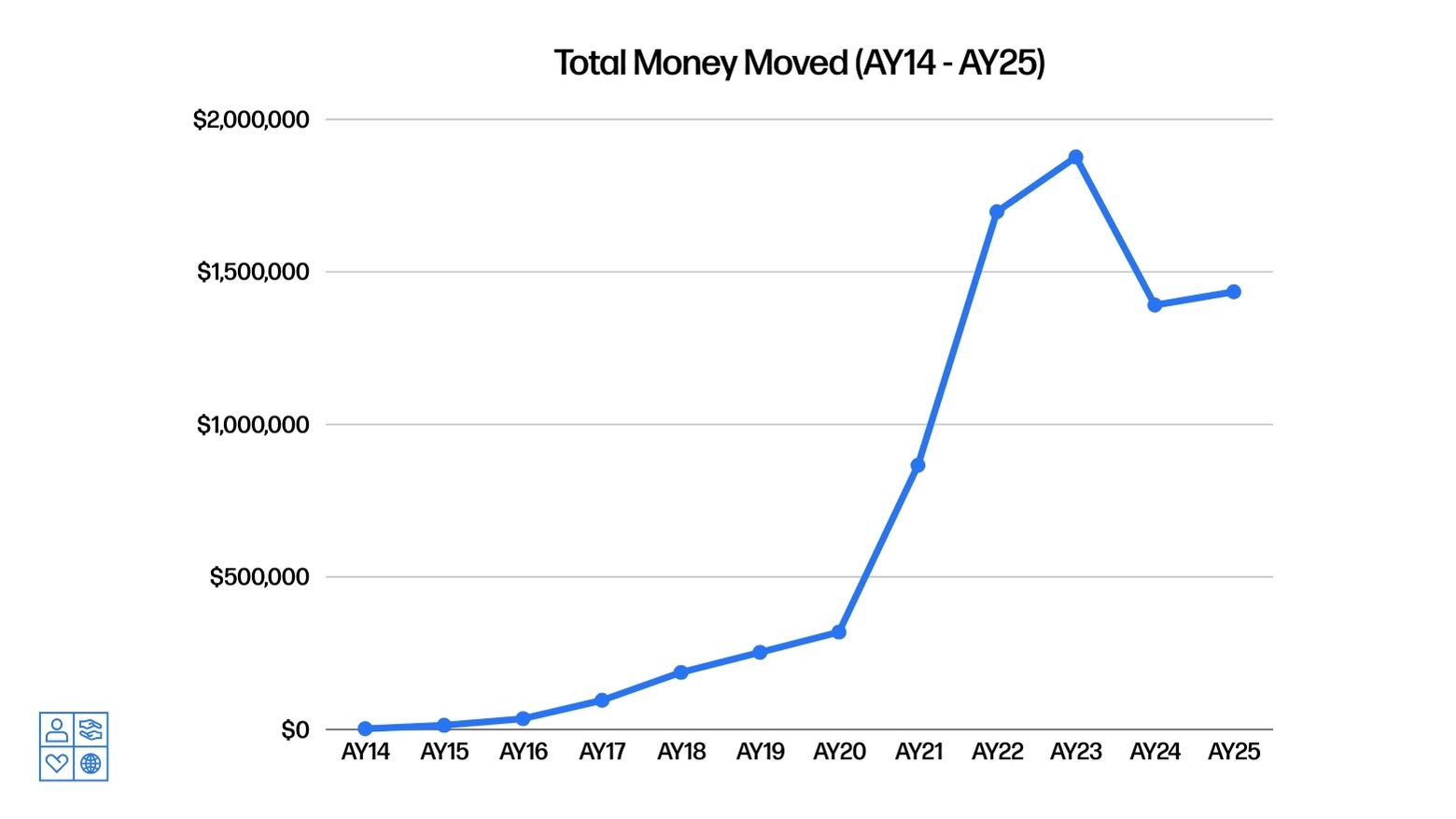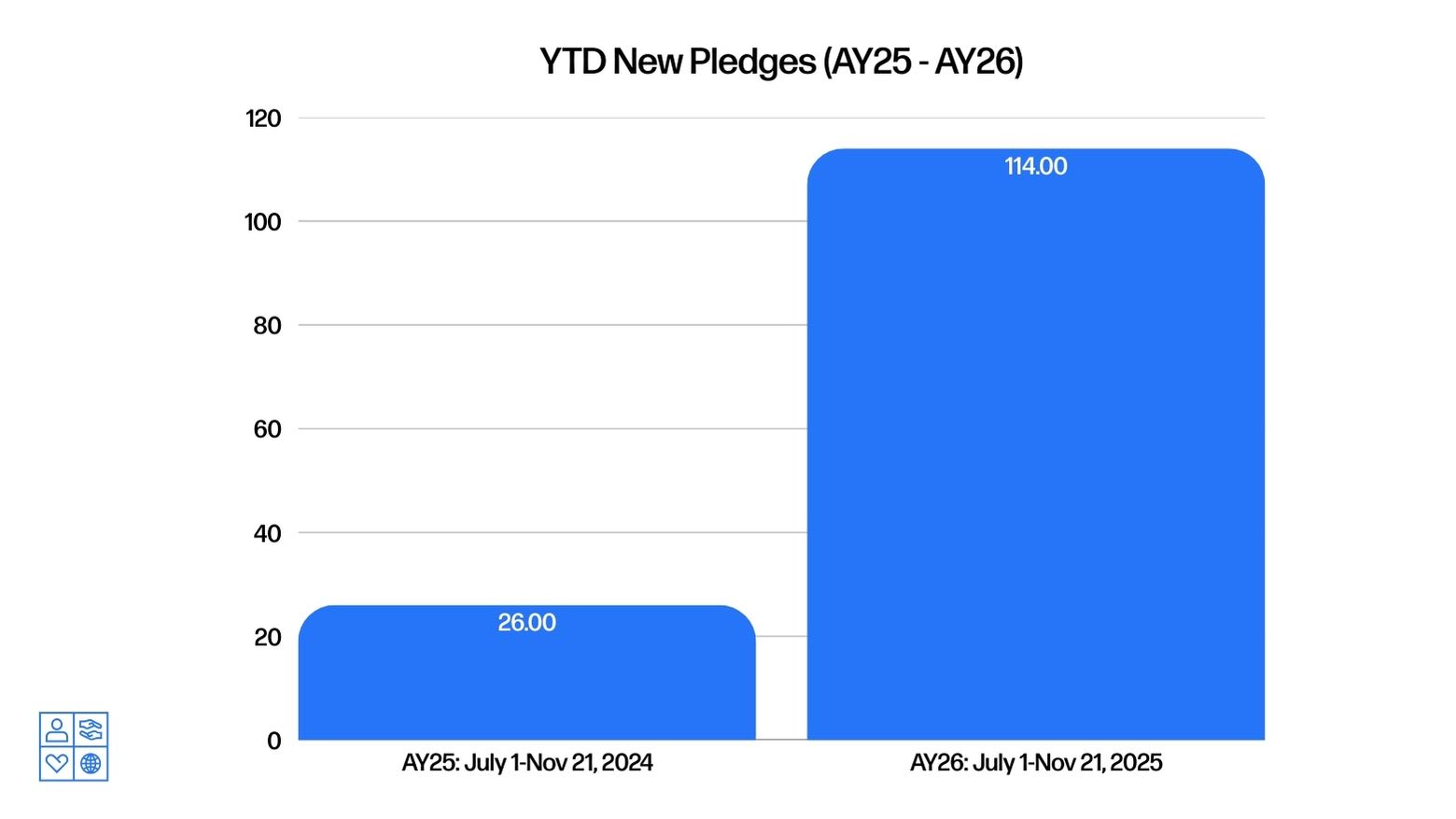
Why marginal funding matters for the front door of effective giving.
TLDR/ Overview:
- One for the World’s mission is to scale the effective giving movement on poverty and public health. As such, we’re the tip of the spear for effective giving in the English-speaking world.
- We’ve focused on two target segments: MBA students and early-career professionals in tech, consulting, and finance.
- This year we’ve seen strong early momentum: pledges up 4× YTD (July 1 → now), ≈$300k moved since July 1, improved retention, and strong comms/social media growth.
- We are currently working to fill a $160k budget deficit for fiscal year AY26 (ends June 30th).
- Marginal funding would ensure that we can continue driving our growth strategy with additional workplace talks, chapter support, and pledge platform tech improvements.
- Your support helps grow the entire effective giving movement — not just OFTW.
Since last year…
In 2024, One for the World shared that we were entering a new phase of growth under new leadership, with plans to validate our value proposition, strengthen our programs, and expand our outreach across campuses and workplaces.
Since then, we identified our two target segments and value propositions. We reorganized our team structure, strengthened our programming for chapters and workplace engagement, and improved our donor platform (Donational) through an acquisition. We managed to do all of this under budget (3% YTD - where YTD reflects July 1 → today) while continuing to move more funding to highly effective charities.
At the same time, our operating landscape has become more challenging. Open Philanthropy no longer contributes to our operating budget, and our projected AY26 deficit is $160k unless we secure additional operating support. Our runway extends through April — about five months.
What OFTW does
Our mission is to grow the effective giving movement by helping more people donate to the world’s most cost-effective charities fighting global extreme poverty, and specifically working to avert the preventable deaths of children under 5.
We do this by meeting people early in their careers in the US, UK, Canada, and Australia:
- University chapters introduce effective giving and the 1% Pledge at a decisive moment in students’ lives; including a strong focus on MBA programs.
- Community Ambassadors bring effective giving into major companies through workplace talks and peer-led events.
- The 1% Pledge lowers friction and gives people a simple, sustainable entry point to effective giving.
And we do this as a small, international team, which brings diverse perspectives and helps us reach people with different lived experiences.
What’s changed… momentum that matters
This year brought some of our strongest early indicators yet:
- 33 active chapters, including an expanding MBA presence,
- New pledges up 4× compared to last year (26 → 114 YTD);
- 11 Community Ambassadors (5 newly recruited) expanding workplace reach;
- 18 talks and events delivered YTD, with at least a dozen more planned during Giving Season;
- Approximately $300k money moved YTD, projected $1.8M for AY26;
- Retention improved (attrition down to 12.9%, from 16%);
- Donational improvements with evergreen payments launched and tipping for ops underway;
- Strengthened communications and social media presence, including consistent posting, improved visual design, clearer messaging across chapters and workplace outreach, and new initiatives like our 1% Gallery, which highlights community pledgers and their stories. (Example: our recent Instagram feature);
- Partnered with Double Up Drive again this Giving Season to increase our combined impact.
These results give us confidence that our strategy is working — but continuing this progress depends on extending our operating runway.


What marginal funding enables
With additional operating support, OFTW will:
- Extend our runway during a critical stage of our growth strategy;
- Scale workplace outreach, our fastest-growing channel for pledges and money moved;
- Strengthen Donational, supporting better donor retention and recurring giving;
- Maintain momentum across our chapters and Community Ambassadors.
Why marginal funding matters
Our strategy is working: retention is improving, pledges are up, chapters are growing, and workplace engagement is stronger than ever. But without an operating runway, this progress will stall just as it’s beginning to accelerate. Marginal funding now allows us to continue scaling the channels that bring new donors into effective giving. Your support doesn’t just fund OFTW — it strengthens the effective giving movement itself.

Disclaimer: I'm one of the community ambassadors.
I imagine the numbers here probably underestimate the scale of the multiplier effect. There exist people inspired to give effectively by event attendance who don't log or advertise it. And there exist people who will go to something set up by One for the World, do their research into effective giving, and then 10% pledge at Giving What We Can without involving One for the World. Which is all a major headache for One for the World's statistical tracking. Nonetheless, the trend lines are very clear that the current approach is working well.
I would consider donations to One for the World one of the most effective ways of funding effective global health and development work.
It is known why
Open PhilanthropyCoefficient Giving is no longer contributing to the operating budget?(I generally don't weight such considerations much in my own decisionmaking per se for various reasons, but do consider the rationale if one is known or can be guessed.)
I'm going to have a crack at the rationale, it's probably several things:
Thank question and great answer Kestrel. I'll add some color.
There's a few reasons why Open Phil (now CG) no longer funds OFTW. As for the weight between these reasons, they can jump in if they'd like but here's a few dynamics:
We are looking at becoming competitive enough to receive CG funding within the next two years by better capturing off-platform data (we likely are missing six figures worth of money moved a year due to dynamic Kestrel mentioned), dramatically improving our money moved metrics, and lastly, maintaining operational excellence through austere overhead (while still investing in our team appropriately). However, the early signal looks like our growth strategy is working, with the 4x pledge count YTD as a leading indicator.
Thanks for this -- I donated. Although I support better measures to minimize leakage, it seems plausible to me that OFTW's theory of impact just can't be measured as confidently as that of many other organizations in this space. Effective-giving outreach to university students, who generally have no/little income in the short run, strikes me as prone to measurement difficulties. In contrast, I'd expect that most impact for a small-country effective giving organization flows through the organization (so the donors secure the relevant tax advantages).
We should probably allow some impact credit for raising awareness of a problem + an effective action in response, even if there is no discernable effect in the measurement period. For example, I think attending something like an Oxfam Hunger Banquet during the first semester of college deserves some non-trivial amount of credit for my own giving, but the organizers will never account for that in a cost-effectiveness analysis. But I find it difficult to decide how much credit to assign for generating awareness / change in attitudes that has not (and may never) blossom into effective action.